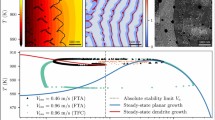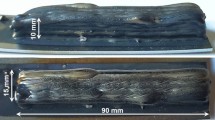Abstract
Superelasticity of shape memory alloy (SMA) results from the reversible thermoelastic martensitic transformation. Although this property has been studied extensively at the macroscale, the study of this superelastic behavior at the micro/nanoscale is relatively new. In this work, we processed TiNi-based SMAs with different compositions and different phase transformation temperatures. Nanoindentations were performed with different peak loads and at various temperatures to systematically characterize the degree of localized stress-induced martensitic transformation at the nanoscale for each SMA. Micropillar compression tests were also performed to study the global superelastic behavior at the microscale. The physics of stress-induced martensitic transformation versus the phase transformation temperature, the testing temperature, and the peak load relations was explored and the difference between the localized and the global superelastic behaviors was discussed. Our results demonstrate the potential of integrating TiNi-based SMAs into functional micro- and nanodevices.








Similar content being viewed by others
References
K. Otsuka and K. Shimizu: Pseudoelasticity and shape memory effects in alloys. Int. Metals Rev. 31, 93 (1986).
S. Miyazaki, K. Otsuka, and C.M. Wayman: The shape memory mechanism associated with the martensitic transformation in Ti-Ni alloys—I. Self-accommodation. Acta Metall. 37, 1873 (1989).
S. Miyazaki, K. Otsuka, and C.M. Wayman: The shape memory mechanism associated with the martensitic transformation in Ti-Ni alloys—II. Variant coalescence and shape recovery. Acta Metall. 37, 1885 (1989).
S.K. Wu and H.C. Lin: Recent development of TiNi-based shape memory alloys in Taiwan. Mater. Chem. Phys. 64, 81 (2000).
A.J. Muir Wood and T.W. Clyne: Measurement and modelling of the nanoindentation response of shape memory alloys. Acta Mater. 54, 5607 (2006).
A. Nespoli, S. Besseghini, S. Pittaccio, E. Villa, and S. Viscuso: The high potential of shape memory alloys in developing miniature mechanical devices: A review on shape memory alloy mini-actuators. Sens. Actuators A 158, 149 (2010).
Y. Fu, H. Du, W. Huang, S. Zhang, and M. Hu: TiNi-based thin films in MEMS applications: A review. Sens. Actuators A 112, 395 (2004).
Y. Bellouard: Shape memory alloys for microsystems: A review from a material research perspective. Mater. Sci. Eng., A 481–482, 582 (2008).
G.A. Shaw, D.S. Stone, A.D. Johnson, A.B. Ellis, and W.C. Crone: Shape memory effect in nanoindentation of nickel–titanium thin films. Appl. Phys. Lett. 83, 257 (2003).
X.G. Ma and K. Komvopoulos: Nanoscale pseudoelastic behavior of indented titanium–nickel films. Appl. Phys. Lett. 83, 3773 (2003).
P. Yiu, J.S.C. Jang, S.Y. Chang, Y.C. Chen, J.P. Chu, and C.H. Hsueh: Plasticity enhancement of Zr-based bulk metallic glasses by direct current electropulsing. J. Alloys Compd. 525, 68 (2012).
P. Yiu, Y.C. Chen, J.P. Chu, S.Y. Chang, H. Bei, J.S.C. Jang, and C.H. Hsueh: Rapid relaxation and embrittlement of Zr-based bulk metallic glasses by electropulsing. Intermetallics 34, 43 (2013).
J. Pfetzing-Micklich, N. Wieczorek, T. Simon, B. Maaß, and G. Eggeler: Direct microstructural evidence for the stress induced formation of martensite during nanoindentation of NiTi. Mater. Sci. Eng., A 591, 33 (2014).
J. San Juan, M.L. No, and C.A. Schuh: Thermomechanical behavior at the nanoscale and size effects in shape memory alloys. J. Mater. Res. 26, 2461 (2011).
C.P. Frick, S. Orso, and E. Arzt: Loss of pseudoelasticity in nickel–titanium sub-micron compression pillar. Acta Mater. 55, 3845 (2007).
D.M. Norfleet, P.M. Sarosi, S. Manchiraju, M.F-X. Wagner, M.D. Uchic, P.M. Anderson, and M.J. Mills: Transformation-induced plasticity during pseudoelastic deformation in Ni–Ti microcrystals. Acta Mater. 57, 3549 (2009).
J. Ye, R.K. Mishra, A.R. Pelton, and A.M. Minor: Direct observation of the NiTi martensitic phase transformation in nanoscale volumes. Acta Mater. 58, 490 (2010).
C.P. Frick, B.G. Clark, A.S. Schneider, R. Maab, S. Van Petegem, and H. Van Swygenhoven: On the plasticity of small-scale nickel-titanium shape memory alloys. Scr. Mater. 62, 492 (2010).
M.L. Bowers, X. Chen, M. De Graef, P.M. Anderson, and M.J. Mills: Characterization and modeling of defects generated in pseudoelastically deformed NiTi microcrystals. Scr. Mater. 78–79, 69 (2014).
J. Frenzel, E.P. George, A. Dlouhy, Ch. Somsen, M.F-X. Wagner, and G. Eggeler: Influence of Ni on martensitic phase transformations in NiTi shape memory alloys. Acta Mater. 58, 3444 (2010).
S. Miyazaki and K. Otsuka: Mechanical behaviour associated with the premartensitic rhombohedral-phase transition in a Ti50Ni47Fe3 alloy. Philos. Mag. 50, 393 (1984).
J. Olbricht, A. Yawny, J.L. Pelegrina, A. Dlouhy, and G. Eggeler: On the stress-induced formation of R-phase in ultra-fine-grained Ni-rich NiTi shape memory alloys. Metall. Mater. Trans. A 42, 2556 (2011).
A.J. Muir Wood, S. Sanjabi, Y.Q. Fu, Z.H. Barber, and T.W. Clyne: Nanoindentation of binary and ternary Ni–Ti-based shape memory alloy thin films. Surf. Coat. Technol. 202, 3115 (2008).
A. Ishida and M. Sato: Thickness effect on shape memory behavior of Ti-50.0at.%Ni thin film. Acta Mater. 51, 5571 (2003).
J. Zhang, C. Somsen, T. Simon, X. Ding, S. Hou, S. Ren, X. Ren, G. Eggeler, K. Otsuka, and J. Sun: Leaf-like dislocation substructures and the decrease of martensitic start temperatures: A new explanation for functional fatigue during thermally induced martensitic transformations in coarse-grained Ni-rich Ti–Ni shape memory alloys. Acta Mater. 60, 1999 (2012).
K.L. Johnson: Contact Mechanics (Cambridge Univ. Press, Cambridge, United kingdom, 1985), pp. 93.
C.H. Hsueh and P. Miranda: Combined empirical–analytical method for determining contact radius and indenter displacement during Hertzian indentation on coating/substrate systems. J. Mater. Res. 19, 94 (2004).
K. Tsuchiya, Y. Hada, M. Ohnuma, K. Nakajima, T. Koike, Y. Todaka, and M. Umemoto: Production of TiNi amorphous/nanocrystalline wires with high strength and elastic modulus by severe cold drawing. Scr. Mater. 60, 749 (2009).
C.P. Frick, T.W. Lang, K. Spark, and K. Gall: Stress-induced martensitic transformations and shape memory at nanometer scales. Acta Mater. 54, 2223 (2006).
K. Otsuka and X. Ren: Physical metallurgy of Ti–Ni-based shape memory alloys. Prog. Mater. Sci. 50, 511 (2005).
H. Zhang, B.E. Schuster, Q. Wei, and K.T. Ramesh: The design of accurate micro-compression experiments. Scr. Mater. 54, 181 (2006).
C.A. Schuh, J.K. Mason, and A.C. Lund: Quantitative insight into dislocation nucleation from high-temperature nanoindentation experiments. Nat. Mater. 4, 617 (2005).
S. Miyazaki, T. Imai, Y. Igo, and K. Otsuka: Effect of cyclic deformation on the pseudoelasticity characteristics of Ti-Ni alloys. Metall. Trans. 17A, 115 (1986).
H. Tobushi, Y. Shimeno, T. Hachisuka, and K. Tanaka: Influence of strain rate on superelastic properties of TiNi shape memory alloy. Mech. Mater. 30, 141 (1998).
J. San Juan and M.L. Nó: Superelasticity and shape memory at nano-scale: Size effects on the martensitic transformation. J. Alloys Compd.. 577S, S25 (2013).
ACKNOWLEDGMENTS
This project was jointly supported by National Taiwan University under Contract No. 102R104100 and Contract No. 103R8918 and SI was supported by the Grant-in-Aid for Scientific Research (C) (KAKENHI, No. 13350837) from Japan Society for the Promotion of Science (JSPS).
Author information
Authors and Affiliations
Corresponding author
Rights and permissions
About this article
Cite this article
Nien, CY., Wang, HK., Chen, CH. et al. Superelasticity of TiNi-based shape memory alloys at micro/nanoscale. Journal of Materials Research 29, 2717–2726 (2014). https://doi.org/10.1557/jmr.2014.322
Received:
Accepted:
Published:
Issue Date:
DOI: https://doi.org/10.1557/jmr.2014.322




